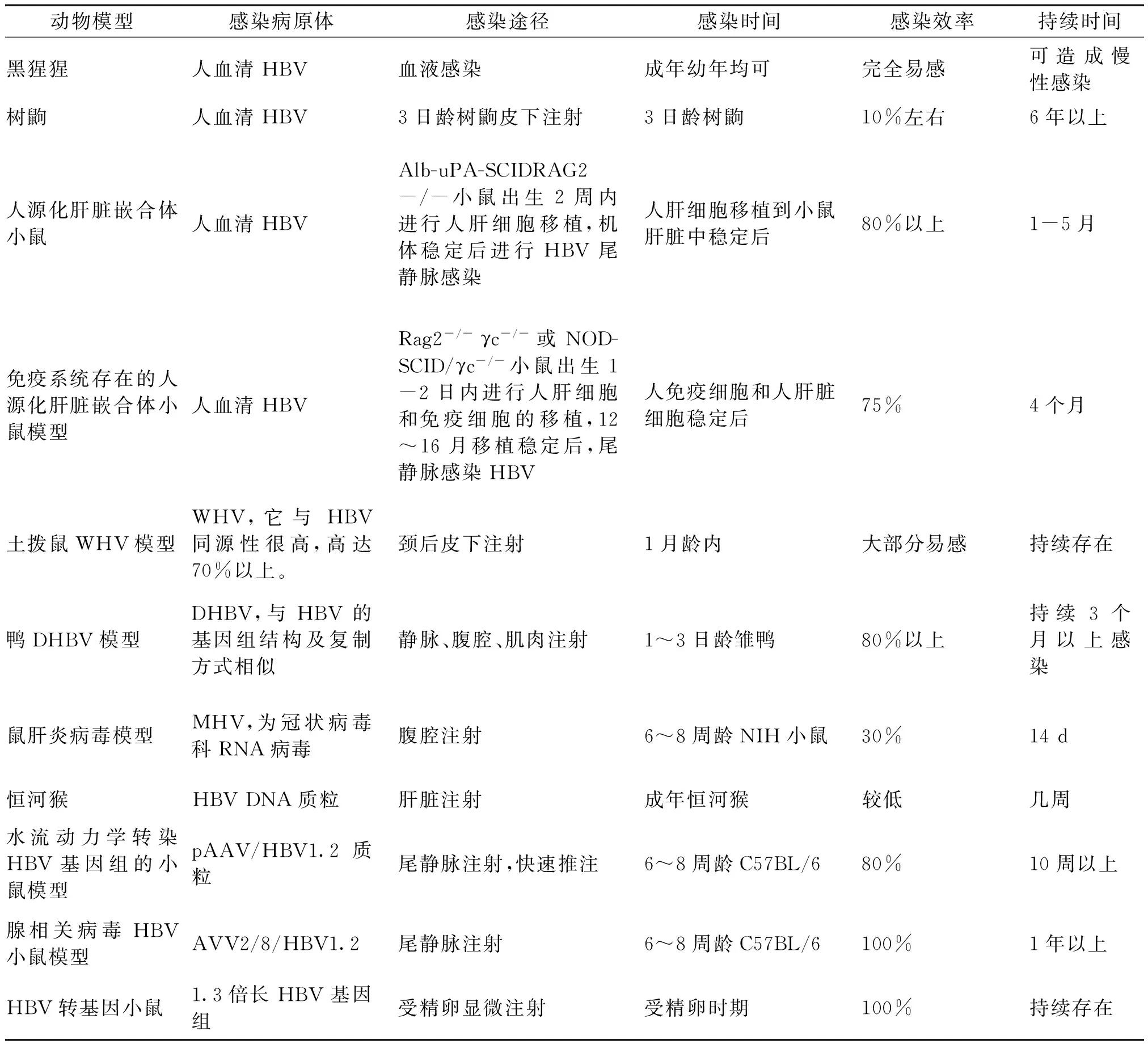乙型病毒性肝炎动物模型的比较分析
2017-08-07刘江宁
张 倩,刘江宁,秦 川
(北京协和医学院比较医学中心 中国医学科学院医学实验动物研究所,卫生部人类疾病比较医学重点实验室,北京 100021)
乙型病毒性肝炎动物模型的比较分析
张 倩,刘江宁,秦 川
(北京协和医学院比较医学中心 中国医学科学院医学实验动物研究所,卫生部人类疾病比较医学重点实验室,北京 100021)
全世界有近2.4亿慢性乙型病毒性肝炎(HBV)患者,尽管已有HBV疫苗和抗病毒治疗药物的产生,但乙肝仍是严重威胁人类健康的传染病。由于缺乏理想的动物模型,使得对于乙型病毒性肝炎的研究受到局限。本综述按照现有HBV动物模型进行对比分析,探讨各种模型病原学和病理与病理生理学应用的区别,以期为科研人员在今后的HBV研究中更好的利用相关资源,提供参考。
乙型病毒性肝炎;动物模型;病原学;病理与病理生理学
全世界约有2.4亿慢性乙型病毒性肝炎患者,其中15%~40%很有可能发展成严重的肝脏疾病,如肝硬化、肝细胞肝癌。每年有超过78万人因此失去生命。尽管已有HBV疫苗和抗病毒治疗药物的产生,但乙肝仍是严重威胁人类健康的传染病。HBV感染和复制并不能直接损伤肝脏细胞,临床症状由宿主免疫反应和病毒复杂的相互作用起引起[1-3],从而导致肝硬化和肝癌的发生[4]。由于HBV宿主的局限性,目前仍没有理想的HBV动物模型用于研究HBV与宿主之间如何相互作用从而导致慢性感染[5]。同时关于慢性感染如何导致肝脏损伤,肝硬化和肝细胞肝癌的机制,目前并不十分清楚。本综述对现有的HBV动物模型,根据其感染的病原种类,导致的病生理变化,发展成为肝癌的情况分别进行介绍,探讨各种模型的应用比较,以使科研人员在今后的HBV研究中更好的利用相关资源,提供参考。
1 病毒病原学特征比较
我们把现有的HBV动物模型分为3类,(1) 直接感染HBV动物模型,如:黑猩猩、树鼩,同时对小鼠进行了改造,把人的肝细胞移植到小鼠肝脏上,使得可以直接感染HBV的人源化肝脏嵌合体小鼠模型等;(2) HBV类似病毒的动物模型,如:土拨鼠肝炎病毒模型、鸭肝炎病毒模型等;(3) HBV DNA转染小鼠模型,如:水流动力学转染HBV基因组小鼠模型等(表1)。
2 病理与病理生理学特征比较:
HBV的感染和复制并不能直接造成肝脏细胞的损伤,肝脏病变是由于病毒与机体的免疫相互作用导致。对表现出急、慢性肝炎的一些病理与病理生理上变化的HBV动物模型进行归类比较(表2)。
3 各类模型的应用比较
根据动物模型的应用范围,比较其优缺点,对各种模型的应用进行分析讨论,从而为科学研究提供一定的参考(表3)。

表1 病原学特征比较

表2 病理与病理生理学特征比较

表3 各类模型的应用比较
4 总结
在疾病的研究中,理想的HBV感染动物模型,至少应具备两个基本条件:(1)HBV在肝脏细胞内保持高水平的复制;(2)能模拟HBV感染人的病理过程,也就是伴有持续性HBV感染及相应的病理变化特征[26]。由于HBV严格种属特异性的特点,导致一直缺乏合适的HBV体内感染的实验模型,使得HBV的相关基础和临床研究不能得到很好发展。虽然小鼠不是HBV天然宿主,但经改造,可达到让小鼠感染HBV的目的。此综述从3个不同角度对HBV感染模型进行比较阐述,在模型的使用中既要考虑到适用性,也要考虑到课题组的实用性。我国是乙肝大国,对于建立HBV更理想的动物模型一直在不懈的研究和探索,NTCP受体的发现,给转基因小鼠打开了另一扇窗,在不久的将来,一定会出现合适的模型,让我们去攻克HBV。
[1] Chen J, Yuan Z. Interplay between hepatitis B virus and the innate immune responses: implications for new therapeutic strategies [J]. Virolog Sin, 2014, 29(1): 17-24.
[2] Wang F-S, Zhang Z. Host immunity influences disease progression and antiviral efficacy in humans infected with hepatitis B virus [J]. Expert Rev Gastroenterol Hepatol, 2009, 3(5): 499-512.
[3] Yang PL, Althage A, Chung J, et al. Immune effectors required for hepatitis B virus clearance [J]. Proc Nat Acad Sci U S A, 2010, 107(2): 798-802.
[4] Scaglione SJ, LOK ASF. Effectiveness of hepatitis B treatment in clinical practice [J]. Gastroenterology, 2012, 142(6): 1360-1368.
[5] Bility MT, LI F, Cheng L, et al. Liver immune-pathogenesis and therapy of human liver tropic virus infection in humanized mouse models [J]. J Gastroenterol Hepatol, 2013, 28(Suppl 1): 120-124.
[6] Maynard JE, Berquist KR, Krushak DH, et al. Experimental infection of chimpanzees with the virus of hepatitis B [J]. Nature, 1972, 237(5357): 514-515.
[7] Wieland SF. The chimpanzee model for hepatitis B virus infection [J]. Cold Spring Harbor Persp Med, 2015, 5(6): pii: a021469.
[8] Wieland S, Thimme R, Purcell RH, et al. Genomic analysis of the host response to hepatitis B virus infection [J]. Proc Nat Acad Sci U S A. 2004, 101(17): 6669-6674.
[9] Lanford RE, Guerra B, Chavez D, et al. GS-9620, an oral agonist of Toll-like receptor-7, induces prolonged suppression of hepatitis B virus in chronically infected chimpanzees [J]. Gastroenterology, 2013, 144(7): 1508-1517, 1517.e1-10.
[10] Gheit T, Sekkat S, Cova L, et al. Experimental transfection of Macaca sylvanus with cloned human hepatitis B virus [J]. J Gen Virol, 2002, 83(7): 1645-1649.
[11] Lucifora J, Vincent I E, Berthillon P, et al. Hepatitis B virus replication in primary macaque hepatocytes: crossing the species barrier toward a new small primate model [J]. Hepatology (Baltimore, Md.), 2010, 51(6): 1954-1960.
[12] Walter E, Keist R, Niederöst B, et al. Hepatitis B virus infection of tupaia hepatocytes in vitro and in vivo [J]. Hepatology, 1996, 24(1): 1-5.
[13] Yang C, Ruan P, Ou C, et al. Chronic hepatitis B virus infection and occurrence of hepatocellular carcinoma in tree shrews (Tupaia belangeri chinensis) [J]. Virol J, 2015, 12: 26.
[14] Dandri M, Lütgehetmann M. Mouse models of hepatitis B and delta virus infection [J]. J Immunol Methods, 2014, 410: 39-49.
[15] Bility MT, Cheng L, Zhang Z, et al. Hepatitis B virus infection and immunopathogenesis in a humanized mouse model: induction of human-specific liver fibrosis and M2-like macrophages [J]. PLoS Pathogens, 2014, 10(3): e1004032.
[16] 谈博, 张奉学, 操红缨, 等. 鸭乙型肝炎病毒感染模型及其方法学研究进展[J]. 热带医学杂志, 2005(01): 111-113, 117.
[17] 覃小敏. 慢性病毒性肝炎小鼠动物模型的建立及其特征分析 [D]. 华中科技大学, 2006.
[18] Guidotti LG, Matzke B, Schaller H, et al. High-level hepatitis B virus replication in transgenic mice [J]. J Virol, 1995, 69(10): 6158-6169.
[19] Liu F, Song Y, Liu D. Hydrodynamics-based transfection in animals by systemic administration of plasmid DNA [J]. Gene Ther, 1999, 6(7): 1258-1266.
[20] Yang PL, Althage A, Chung J, et al. Hydrodynamic injection of viral DNA: a mouse model of acute hepatitis B virus infection [J]. Proc Nat Acad Sci U S A. 2002, 99(21): 13825-13830.
[21] Bramson JL, Graham FL, Gauldie J. The use of adenoviral vectors for gene therapy and gene transfer in vivo [J]. Curr Opinion Biotechnol, 1995, 6(5): 590-595.
[22] von Freyend MJ, Untergasser A, Arzberger S, et al. Sequential control of hepatitis B virus in a mouse model of acute, self-resolving hepatitis B [J]. J Viral Hepatitis, 2011, 18(3): 216-226.
[23] Mingozzi F, Liu Y-L, Dobrzynski E, et al. Induction of immune tolerance to coagulation factor IX antigen by in vivo hepatic gene transfer [J]. J Clin Investig, 2003, 111(9): 1347-1356.
[24] Yang D, Liu L, Zhu D, et al. A mouse model for HBV immunotolerance and immunotherapy [J]. Cell Mol Immunol, 2014, 11(1): 71-78.
[25] DIion S, Bourgine M, Godon O, et al. Adeno-associated virus-mediated gene transfer leads to persistent hepatitis B virus replication in mice expressing HLA-A2 and HLA-DR1 molecules [J]. J Virol, 2013, 87(10): 5554-5563.
[26] Dembek C, Protzer U. Mouse models for therapeutic vaccination against hepatitis B virus [J]. Med Microbiol Immunol, 2015, 204(1): 95-102.
Comparative analysis of animal models of hepatitis B viral hepatitis
ZHANG Qian,LIU Jiang-ning,QIN Chuan
(Comparative Medicine Center, Peking Union Medical College (PUMC); Institute of Laboratory Animal Science, Chinese Academy of Medical Sciences (CAMS); Key Laboratory of Human Disease Comparative Medicine, Ministry of Health, Beijing 100021, China)
There are approximately 240 million patients with chronic hepatitis B virus (HBV) in the world. Despite the production of HBV vaccines and antiviral drugs, HBV still remains a serious threat as an infectious disease to human health. Due to the lack of an ideal animal model, the study of HBV is limited. This review was to analyze in accordance with existing HBV animal model, to explore the differences in applications of various models regarding their etiology, pathology and pathophysiology. thus, to provide a reference for researchers in future HBV research to better use the resources.
Hepatitis B virus; Animal model; Etiology; Pathology; Pathophysiology
艾滋病、病毒性肝炎、结核病及其他新发突发传染病实验动物的研究专项,编号:(2012ZX10004501)。
张倩,女,博士研究生,研究方向:病理学与病理生理学,传染性疾病与动物模型的研究。E-mail: zhangqianbisheng@163.com。
秦川,女,研究院,教授,博士生导师,研究方向:病理学与病理生理学。Email: qinchuan@pumc.edu.cn。
综述与专论
R-33
A
1671-7856(2017) 06-0072-05
10.3969.j.issn.1671-7856. 2017.06.015
2016-09-30
